Did you know that Albert Einstein is one of the founders of Laser Therapy?

Laser therapy has grown in popularity in recent years. Red and NIR (Near Infrared) light therapy in particular is growing rapidly and there are many reasons for this. More than 4.000 scientific and clinical studies on Pubmed.gov prove that red and Near Infrared light cause the mitochondria to produce ATP. So you literally get more energy from exposure to red and Near Infrared light.
How did laser therapy come about?
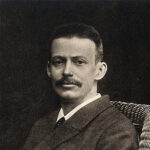
Danish doctor Niels Ryberg Finsen gets the . in 1903 Nobel for medicine and the therapeutic and physiological effects of light treatment by means of artificial light sources.

Albert Einstein was the first to investigate the theory of light beams in 1905. In 1921 he was awarded the Nobel for the explanation of the photoelectric effect.

Physicist Theodore Maiman published the first paper on laser irradiation in relation to health in 1960.

E. Mester, Hungarian scientist, presented a study on the use of lasers in medicine in 1969. He proved that this form of light and energyadministration takes care of many things. Such as more energy, relieving pain, faster healing and recovery.
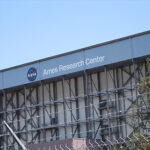
NASA presented a clinical study in 2003 on diode lamps (laser light) that offer promising possibilities for application in the medical and beauty world. The clinical study shows the effectiveness of LED (laser light) on cell renewal.

De Federal Drug Administration (FDA) approved the medical use of Laser Therapy in 2003.
How does a High Power Laser work?
A High Power Laser works by means of laser light. At first glance, this may seem like a ray of red or blue light, but nothing could be further from the truth. The operation of laser light at the correct wavelength with a matching laser handpiece produces amazing results. Each wavelength has different properties. The HPLT diode laser uses a wavelength of 455, 650 and 810 nanometers. This is scientifically 'the gold standard' for photobiostimulation. The pure light from the High Power Laser causes photochemical reactions in the cells instead of thermal ones. The reason for this is that this wavelength is the only one that is positively evidence-based for PPE.
High-level laser treatment gives a boost in cells energy (photobiomodulation) so that the ATP production of a cell is optimized and blood flow and oxygen to the tissue are increased. This in turn increases metabolism in the cells of the tissue and provides the optimal environment for tissue to heal. In many cases the patient's treatment time is shorter and the treatment is also painless.
A treatment with our laser works with the help of a gas controlled laser module, which with a scientifically proven light color of 810 nm directs the energy directly to the cells in the deeper layers under the skin.
The light enters the mitochondria of the cell and is absorbed by the chromophores, including the protein cytochrome c oxidase (OCC), which then increases the cell's activity.
As a result of this increased activity, three molecules are affected: adenosine triphosphate (ATP), reactive oxygen species (ROS) and nitric oxide (NO), which together ensure a faster and more effective recovery from pain, inflammation or infections.
This scientifically proven process is also called: photobiomodulation.
The effect of laser therapy
1 – Laser light with a wavelength of 810nm is delivered through a fiber with a therapeutic handpiece through the skin surface to the tissue.
2 – The light enters the mitochondria of the cell and is absorbed by the chromophores, including the protein cytochrome c oxidase (CCO) which then increases the activity of the cell.
3 – As a result of this increased activity, three molecules are affected: adenosine triphosphate (ATP), reactive oxygen species (ROS) and nitric oxide (NO).
What do the abbreviations mean?
ATP – Adenosine triphosphate; an increase in ATP, the main energy source for most cell functions, increases the cell's ability to fight infection and speeds up the healing process.
ROS – reactive oxygen species; the modulation of ROS activates transcription factors that positively affect cellular repair and healing.
DO NOT – Nitric oxide; the release of NO, a potent vasodilator, increases circulation, reduces inflammation and improves the transport of oxygen and immune cells through tissue.
Do you want to know more?
Be amazed, book a demo
What are the differences in wavelengths?
The great advantage of this wavelength is that it is not absorbed by the water, but exclusively by melanin (in the skin) and hemoglobin (in the blood). Another property of this wavelength is that it targets fungal and bacterial infections.
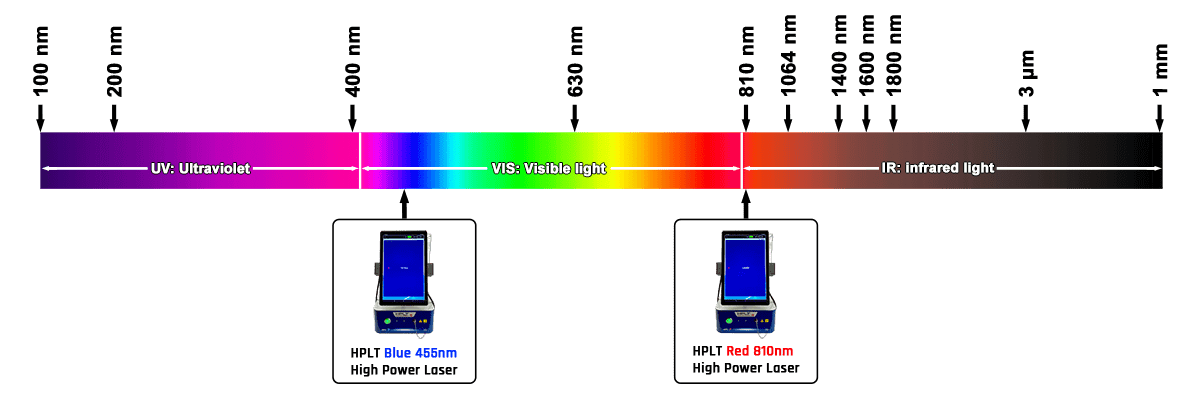
What is the difference between a Low Level Laser and a High Power Laser?
Of a High Power Laser (class IV) is spoken when we talk about a laser with a power of 500mW or more. Other names for a High Power Laser are HPLT, HILT and High Intensity Laser.
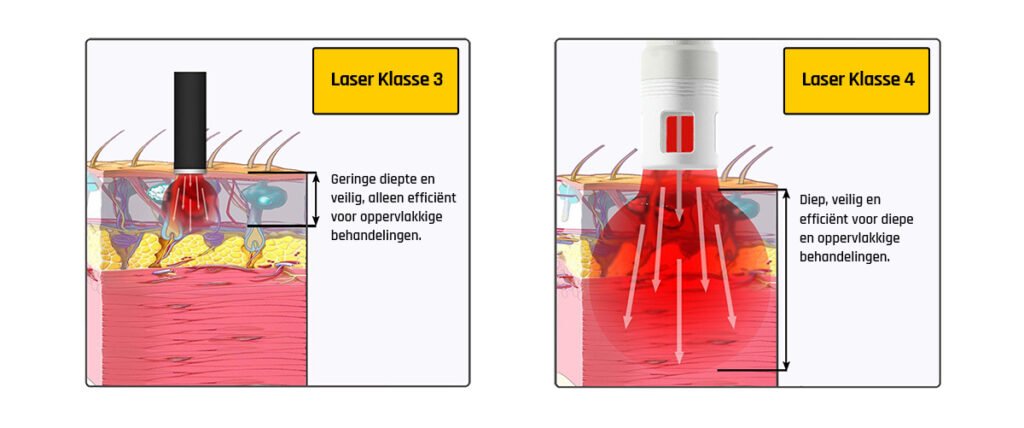
Because a Low Level Laser may have a maximum power of 500mW, multiple laser diodes are used.
The powers of 500mW cannot be added together.
An example: if you hang 2 60 Watt lamps in a room, they together give 60 Watts of light and not 120 Watts! This is no different with a laser.
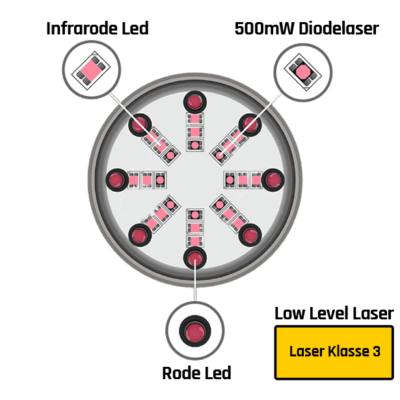
Why choose a High Power Laser?
If the complaint is deeper in the body, the power of the light beam decreases. With a High Power Laser, the power can be increased slightly, so that the area where the complaint is located can still be properly reached.
- With a High Power Laser you are able to perform a Low Level laser treatment within a sixth of the time without overheating. Immediately Low Level Laser, however, you cannot perform deep High Power laser treatments.
- Low Level laser therapy can be used by anyone. This may seem like an advantage, but a professional is trained and knows where the problem is or where the problem is coming from. A High Power laser treatment may only be performed by a professional who has received extensive training on the use of the laser when purchasing a laser and who knows what the contraindications are.

Research about High Power Lasers 455/810nm & Laser Therapy
LED light therapy was developed by NASA in the eighties with the aim of improving wound healing and promoting tissue growth in space.
LED light therapy has several names. The most commonly used are: High Power Laser Therapy (HPLT), Photobiomodulation (PBM), High Intensity Laser Therapy (HILT) and Phototherapy.
Science has now shown that LED light therapy stimulates cell division and the production of new cells and repairs tissues.
An enormous amount of studies have shown that laser treatments in humans and animals have astonishing results and have proven that pain complaints, infections and/or wounds disappear and/or heal in a faster and more efficient way compared to the more traditional approach through the use of drugs.
Reliable Studies on High Power Laser Therapy
 Over the years, a huge amount of substantiated research has been done worldwide. A widely used reliable source for medical research is Pubmed. This database contains 30 million biomedical references from 80 countries. Pubmed is updated and maintained daily by US National Library of Medicine (NLM), the world's largest medical library.
Over the years, a huge amount of substantiated research has been done worldwide. A widely used reliable source for medical research is Pubmed. This database contains 30 million biomedical references from 80 countries. Pubmed is updated and maintained daily by US National Library of Medicine (NLM), the world's largest medical library.
Below you will find a number of references to studies on the effect of High Power Laser Therapy.
| View Research |
Citation Research on High Power Laser Therapy (810Nm)






